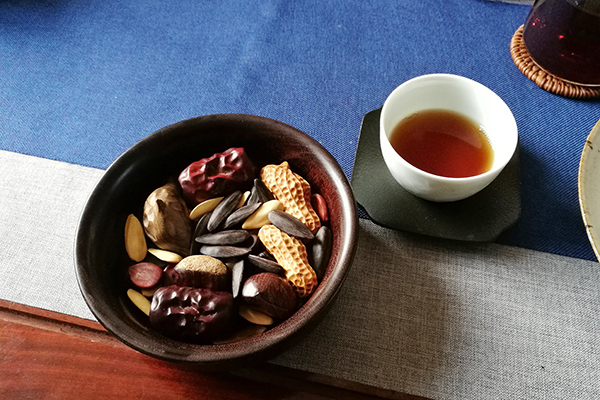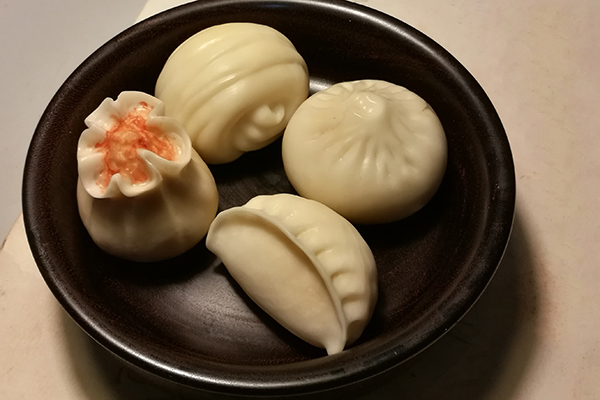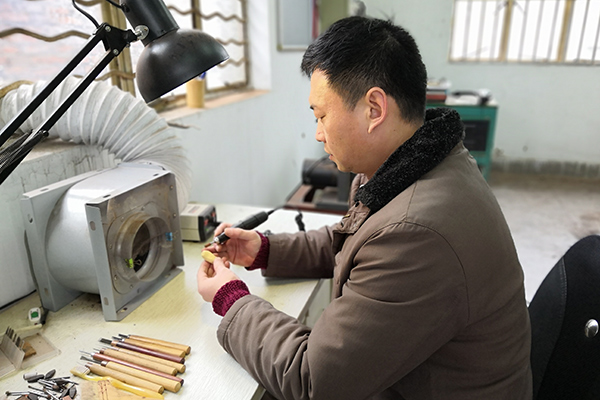 |
Zhou Wei's lifelike breakfast items, seeds and nuts are all made from different kinds of wood. [Photo provided to China Daily] |
The art of illusion is alive and well in the work of one Yangzhou artisan, who creates seemingly tasty souvenirs to celebrate the local zaocha culture, Cheng Yuezhu reports. Yangzhou is a city in Jiangsu province renowned for its long history, picturesque scenery, laid-back lifestyle and zaocha culture. Literally translated as "morning tea", zaocha offers locals the prospect of a pleasant morning spent sipping aromatic tea and sampling tasty delicacies.
However, tourists find it tricky to take these fine, fluffy steamed bites hundreds of kilometers away as gifts for friends and family. This has led one Yangzhou craftsman to come up with a novel solution to address this minor disappointment.
The breakfast snacks Zhou Wei creates are crystalline in texture and exquisite in form with the aroma of freshly cut wood. But these delicacies are in fact statuettes carved into souvenirs unique to the Yangzhou region.
Inside each bamboo steamer are four morning favorites-a baozi (stuffed bun), a zhengjiao (steamed dumpling), a shaomai (steamed dumpling with glutinous-rice filling) and the iconic Yangzhou nibble, qianceng yougao (multilayered steamed cake).
 |
[Photo provided to China Daily] |
Although inedible, the mementos serve a practical purpose and retain a certain cultural value. Apart from serving as home ornaments, these sculptures are used in Chinese tea culture as chachong, or "tea pets", a practice said to have originated in Jiangsu province and dates back to the Yuan Dynasty (1271-1368).
As the name implies, tea pets are statuettes placed on tea trays to add spice to the tasting experience. Soaked in tea every day, the statuettes take on a natural patina and become smoother and more vivid through daily use, Zhou says.
For the material, Zhou chooses Chinese boxwood and tagua nuts, both of which are economical and easy to find. "Boxwood is used commonly throughout the Yangtze River basin. Its consistent quality makes it ideal for mass production. Tagua nuts, while having a color resembling that of steamed buns, are better suited to meticulous hand carving," Zhou says.
Apart from these Yangzhou breakfast items, Zhou also makes a variety of lifelike fruits, seeds and nuts-including red dates, chestnuts, peanuts and melon seeds-from different kinds of wood that can easily fool the eye.
"When my friends visit me at my studio, they sometimes pick up a wooden melon seed and try to crack it open. It still amuses me and makes me proud when they do that," Zhou says.
Zhou is not a full-time artisan. He specializes in classical garden design and only started carving wood as a hobby in 2012 at the age of 39.
"Working in traditional Chinese gardens, I am exposed daily to antique furniture, wooden structures and woodcarving patterns," Zhou says. "I used to be an art teacher, so I thought I would give woodcarving a try."
 |
Zhou Wei makes statuettes using electric and self-designed burins. His creations are inspired by the morning-tea culture of Yangzhou, Jiangsu province. [Photo provided to China Daily] |
When Zhou started out, he only had basic burins, but he now owns a fully equipped studio with electric burins and even a CNC engraving machine.
Exploring woodcarving as a hobby allows him the freedom to break with convention and try innovative methods. Dissatisfied with traditional burins, he designed his own set and had them custom-made.
Even the shavings and scraps can prove useful. When making a chestnut, Zhou often uses sawdust to imitate the hilum at the end of the nutshell to make it more convincing.
"The way I judge these seeds is by closing my eyes and holding them-both a real seed and my carving-in my hand. When I cannot tell them apart, the product is complete," Zhou says.
Zhou's idea for making statuettes inspired by morning-tea refreshments came from his observations of the modern souvenir market. Living close to Dongguan Street, a historical site and local tourist attraction, he felt that many of the objects on sale were indistinguishable from any others sold at tourism spots around China.
Zhou therefore started developing innovative tourism products. "There are a lot of sculptures of mythical dragons and phoenixes on the market, while the most common objects are rarely represented. Breakfast foods like buns and dumplings are more likely to arouse empathy."
And while many people are wowed by the authentic appearance of Zhou's creations, his love for Yangzhou culture and his innovative approach have also moved many others.
"A true artist always retains the spirit of craftsmanship. We need Zhou's virtuosity in our lives," says Yangzhou resident Zhang Xianjun.
Contact the writer at chengyuezhu@chinadaily.com.cn

Presented by Chinadaily.com.cn Registration Number: 10023870-7
Copyright © Ministry of Culture, P.R.China. All rights reserved